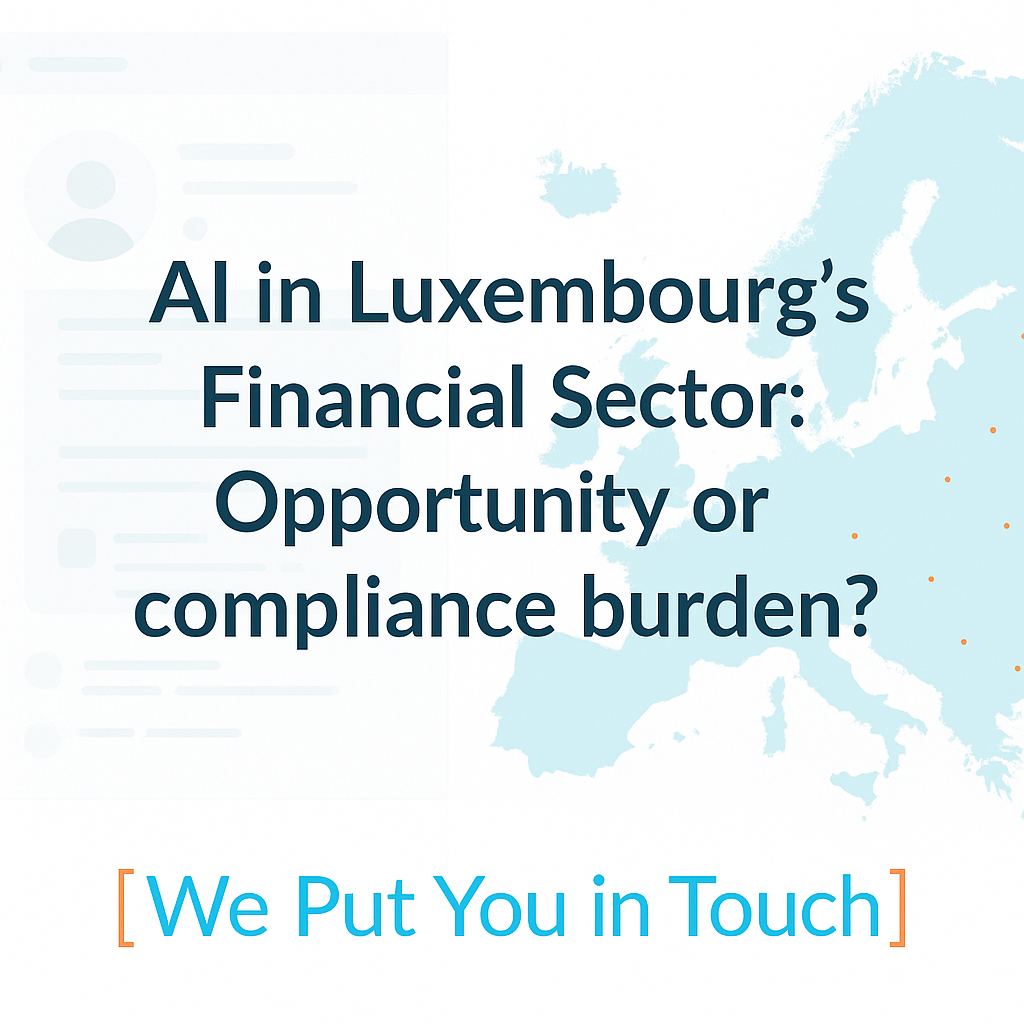
Artificial Intelligence in Luxembourg’s Financial Sector: Navigating Opportunities and Regulatory Challenges
Introduction
Luxembourg’s financial sector is entering a pivotal era as artificial intelligence (AI) technologies become increasingly embedded in core business and compliance functions. In May 2025, the Banque centrale du Luxembourg (BCL) and the Commission de Surveillance du Secteur Financier (CSSF) released a second thematic review on AI, reflecting both rising adoption and heightened scrutiny. The message is clear: AI presents major opportunities for the financial industry, but institutions must be prepared to manage the risks, comply with evolving regulations, and rethink how they operate.
1. AI in Luxembourg: Maturity and Momentum
According to the BCL/CSSF review, over 460 financial institutions were surveyed this year, a significant expansion from 2023. More than 70% of respondents reported using or experimenting with AI tools, particularly in areas like anti-fraud, customer onboarding, document analysis, and investment analytics. Machine learning and, more recently, generative AI are reshaping front-to-back operations.
Yet despite growing interest, maturity levels vary widely. While some large institutions have AI embedded into strategic processes, many actors—especially smaller firms—remain at early stages of experimentation, constrained by budget, governance limitations, or internal resistance.
2. Where AI Meets Friction: Institutional Pain Points
The promise of AI often clashes with practical and organizational realities:
- Data Quality & Availability: AI systems depend on vast amounts of clean, relevant data. Many firms struggle with siloed legacy systems or incomplete datasets.
- Talent & Know-How: Building and managing AI tools requires specialized skills in data science, compliance, and IT—profiles that remain scarce in a tight labor market.
- Operational Integration: AI is not just a plug-in technology. For it to create value, workflows must be redesigned, responsibilities reassigned, and employees trained. This represents a heavy lift for many structures.
- Regulatory Uncertainty: As European regulation takes shape (notably through the EU AI Act), compliance is both essential and burdensome. Financial institutions must anticipate classification of high-risk systems, new documentation requirements, and growing audit expectations.
- Governance Challenges: Boards are now expected to oversee AI projects with the same rigor as credit or market risks. For many, this requires a steep learning curve.
3. What the EU AI Act Means for Luxembourg
The forthcoming EU Artificial Intelligence Act—expected to enter into force in 2026—classifies AI systems into risk categories and sets out corresponding obligations. Financial institutions using AI for credit scoring, fraud detection, or onboarding will likely fall under the “high-risk” category, triggering mandatory risk assessments, transparency obligations, and human oversight mechanisms.
While this regulatory pressure may seem constraining, it also establishes a clearer framework and levels the playing field. The goal: to make AI adoption safer, fairer, and more accountable. In Luxembourg, this can also serve as a catalyst to professionalize governance and unlock long-term trust in innovation.
4. From Compliance to Strategic Value
The conversation around AI must evolve beyond compliance. Yes, controls are needed, but the real opportunity lies in leveraging AI to rethink business models:
- Enhancing client service through smarter personalization
- Improving efficiency in middle and back-office operations
- Strengthening real-time risk monitoring and scenario analysis
- Exploring use of generative AI in automated reporting and regulatory submissions
- Using predictive analytics for liquidity stress tests and scenario forecasting
More broadly, embracing AI opens doors to a new form of financial intelligence—one that helps organizations anticipate, adapt, and accelerate. Institutions that manage this shift successfully may gain not just efficiency, but competitive differentiation.
To get there, they will need not only technical upgrades but also strong operational execution, sound governance structures, and a change-friendly organizational culture. At the right moment, external perspectives can complement internal efforts.
5. Supervisory Expectations and Self-Assessment
The BCL and CSSF have made it clear: AI-related activities must fall under the same risk-based supervision as any other significant process. Institutions are encouraged to:
- Map their use of AI systems
- Classify them against EU AI Act categories
- Establish internal control frameworks, including model validation, incident handling, and access rights
- Train governing bodies and management on AI-related oversight responsibilities
- Regularly reassess the risk profile of AI applications
Moreover, self-assessment tools are being piloted to help institutions benchmark their AI readiness and identify areas for improvement. Supervisors will also continue conducting horizontal reviews across peer institutions.
6. Luxembourg as a Trustworthy AI Hub?
There is a long-term opportunity for Luxembourg to position itself as a center for trustworthy financial AI—blending innovation with high standards. That means developing talent, enabling secure data infrastructures, encouraging pilot projects under regulatory sandboxes, and promoting cross-sector collaboration.
Some early signs are encouraging. Research partnerships, such as those between universities and private actors, are emerging. The government is investing in digital upskilling. Regulatory clarity is improving. And most importantly, institutions themselves are starting to view AI not just as a tech topic, but as a strategic one.
Conclusion
Luxembourg’s financial ecosystem is at a crossroads. AI is no longer a future concept but a present capability—and one that will shape competitiveness for years to come. The road ahead involves both experimentation and structure, innovation and accountability.
Regulation, far from being a brake, may prove to be an enabler: forcing the clarity, oversight, and investment needed to make AI adoption sustainable. The challenge for institutions is not whether to embrace AI, but how to do so responsibly, strategically, and in ways that create lasting value.
Sources:
CSSF (2025). Deuxième revue thématique sur l’utilisation de l’intelligence artificielle. https://www.cssf.lu/fr/Document/revue-thematique-sur-lutilisation-de-lintelligence-artificielle-dans-le-secteur-financier-luxembourgeois-2/
Banque centrale du Luxembourg (2025). AI and digitalisation in Luxembourg’s financial ecosystem. https://www.bcl.lu/en/Media-and-News/Press-releases/2025/05/index.html
European Commission (2024). Regulation (EU) 2024/1689 – The Artificial Intelligence Act. https://eur-lex.europa.eu/legal-content/EN/TXT/?uri=CELEX%3A32024R1689
European Commission (2024). Artificial Intelligence Act: Overview and timeline. https://digital-strategy.ec.europa.eu/en/policies/regulatory-framework-ai
Luxembourg Chamber of Commerce (2025). AI Trends and Investment in Luxembourg. https://www.cc.lu/toute-linformation/publications/download/815/47595
OECD (2024). OECD AI Policy Observatory. https://oecd.ai/en/
Mirishli, S. (2025). Regulating AI in Financial Services: Legal Frameworks and Compliance Challenges. arXiv:2503.14541. https://arxiv.org/abs/2503.14541
